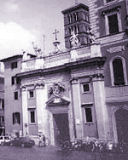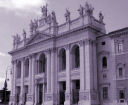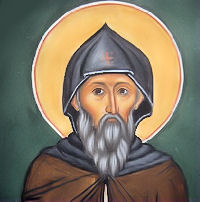Lent: March 30th
Thursday of the Fourth Week of Lent
Other Commemorations: St. John Climacus, Abbot (RM)
» Enjoy our Liturgical Seasons series of e-books!
But I have testimony greater than John's. The works that the Father gave me to accomplish, these works that I perform testify on my behalf that the Father has sent me. Moreover, the Father who sent me has testified on my behalf. But you have never heard his voice nor seen his form, and you do not have his word remaining in you, because you do not believe in the one whom he has sent (John 5:36-38).
| The Station is at the church of Saints Sylvester and Martin, which is one of the most venerable in Rome. It was originally built by Pope St. Sylvester, and still bears his name: but in the sixth century, it was consecrated to St. Martin of Tours. In the seventh century, it was enriched with the relics of Pope Saint Martin, which were brought from Chersonesus, where he had died a martyr a few years before. This church was the first Title of St. Charles Borromeo. It was also that of the learned liturgiologist, the Blessed Joseph-Mary Tommasi, whose body is now venerated in this church, and has been miraculously preserved, even to this day, in a state of incorruption. |  |
Meditation - God's Appeal to All the World
Pilate's "Ecce, Homo!" his appeal to the scornful multitude now on the point of breaking out into mob violence, was even more truly the mighty appeal of God's marvelous mercy to his chosen people and to all the human race.
"Behold the Man!" Behold the Lamb of God, the Son of the living God, in all these unsightly wounds, the most beautiful of men here disfigured beyond recognition, as one stricken by leprosy and all the other filthy diseases of mankind; yes, behold Him here, the most frightful symbol and demonstration of the monstrous evil of mortal sin ever to be given to the world; but even more, behold Him here, the clearest and the mightiest appeal of Heaven to all the world of souls to be converted and to rise from spiritual death to life, true and even divine.
"Behold the Man." O my soul, behold Christ Jesus there as the Lamb of God loaded with your own personal sins and bearing the ghastly wounds your sins inflicted on Him. Pray that you may recognize here, in this reed and purple and crown, God's very own caricature of your senseless pride, of the folly of your imaginary greatness. In that purple rag of a cloak see the sham honor and dignity in which your self-conceit and self-complacency clothe you! In that reed recognize the might of your strength in which you have been trusting. In that crown acknowledge the depth of humiliation you deserve for all your vanity and your open and secret envious ambition for recognition and authority and for honors and offices. O my soul, be honest enough to see and to acknowledge what a spectacle you are to all heaven in the light of the revelation in God's word: "Behold the Man!"
Yet again, "Behold the Man!" Look on Him that you may be filled with hope and courage. Let the crushing truth you have just been making your very own, serve to crush your nauseating and contaminating pride in all its open and especially its hitherto hidden forms. Behold the Man, the Lamb of God laden with your sins, but only to wash them away and to cast them into the deep sea of oblivion; yes, and even to take away your stony heart and give you a heart of flesh, to put His own spirit in your midst, and to cause you to walk in His commandments and to keep His judgments and to do them (Ezech. 36:26-30); in a word, to make a way in your wilderness, that shall be called "The Holy Way." (Isa. 35:6-8.)
Excerpted from Our Way to the Father, Rev. Leo M. Krenz, S.J.
St. John Climacus
Saint John, whose national origin remains unknown, was called Climacus because of a treatise he wrote called The Ladder (Climax) of Paradise. He made such progress in learning as a disciple of Saint Gregory Nazianzen that while still young, he was called the Scholastic. At the age of sixteen he turned from the brilliant future which lay before him, and retired to Mount Sinai, where he was placed under the direction of a holy monk named Martyrius. Once that religious journeyed to Antioch and took the young John with him; they visited Saint Anastasius, a future Patriarch of Antioch, and the Saint asked Martyrius who it was who had given the habit to this novice? Hearing that it was Martyrius himself, he replied, “And who would have said that you gave the habit to an Abbot of Mount Sinai?” Another religious, a solitary, made the same prediction on a similar visit, and washed the feet of the one who would some day be Abbot of Mount Sinai.
Never was there a novice more fervent, more unrelenting in his efforts for self-mastery. On the death of his director, when John was about thirty-five years old, he withdrew into a deeper solitude, where he studied the lives and writings of the Saints and was raised to an unusual height of contemplation. There he remained for forty years, making, however, a visit to the solitaries of Egypt for his instruction and inspiration. The fame of his holiness and practical wisdom drew crowds around him for advice and consolation.
In the year 600, when he had reached the age of seventy-five, he was chosen as Abbot of Mount Sinai by a unanimous vote of the Sinai religious, who said they had placed the light upon its lampstand. On the day of his installation, six hundred pilgrims came to Saint Catherine’s Monastery, and he performed all the offices of an excellent hotel-master; but at the hour of dinner, he could not be found to share the meal with them. For four years, said his biographer, a monk of the monastery of Raithe, “he dwelt on the mountain of God, and drew from the splendid treasure of his heart priceless riches of doctrine which he poured forth with wondrous abundance and benediction.” He was induced by a brother abbot to write the rules by which he had guided his life; and the book which he had already begun, The Ladder, detailing thirty degrees of advancement in the pursuit of perfection, has been prized in all ages for its wisdom, clearness, and unction.
At the end of that time, he retired again to his solitude, where he died the following year, as he had foretold.
—Excerpted from Les Petits Bollandistes: Vies des Saints, by Msgr. Paul Guérin (Bloud et Barral: Paris, 1882), Vol. 4.
Symbols and Representation: abbot carrying a ladder; man having a vision of a ladder being scaled by monks; monk on a ladder; clothed as a monk, sometimes with an Abbot's paterissa (crozier), sometimes holding a copy of his Ladder
Highlights and Things to Do:
- Read more about St. John Climacus:
- Watch this YouTube video on St. John Climacus.
- Pope Benedict XVI devoted his February 11, 2009, General Audience Address to St. John Climacus.
- You can download a pdf of The Ladder of Divine Ascent by John Climacus.
- St. John Climacus is honored also in the Eastern Catholic Churches (Eastern Rite) and Eastern Orthodox Church.

Holy Saturday--Easter Vigil of the Sacred Triduum
Station with San Giovanni in Laterano (St. John Lateran):
The Station returns again to St. John Lateran. During the afternoon of Holy Saturday the faithful were summoned here for the final scrutiny of the catechumens. Then, in the evening began the vigil or night of watching which concluded at dawn with the solemn baptisms—-the neophytes, plunged into the baptismal waters and there buried with Christ, were born to the life of grace at the very time when our Savior came forth triumphant from the tomb at dawn on Easter morning.
For more on San Giovanni in Laterano, see:
For further information on the Station Churches, see The Stational Church.






